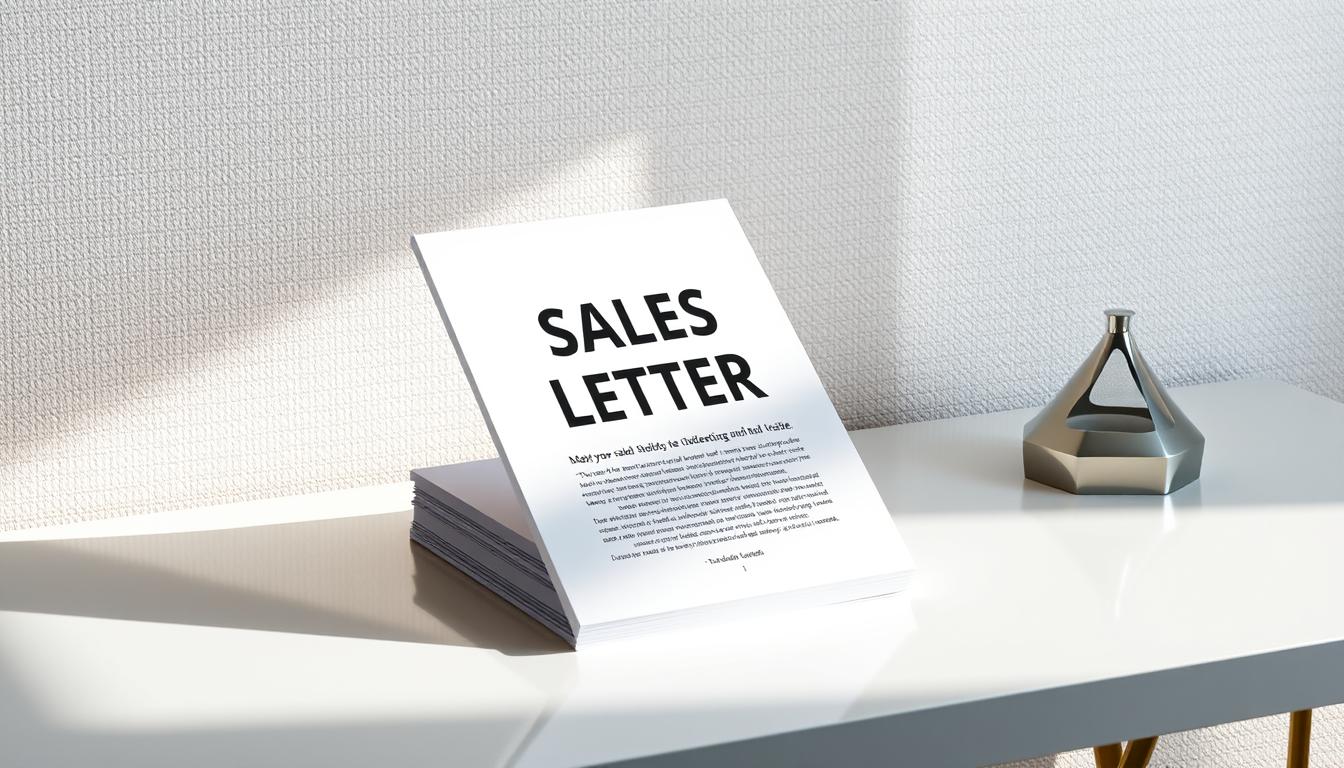In the world of digital marketing, knowing how to write a sales letter is key. It’s not just about selling something. It’s about telling a story that speaks to your audience.
Sales letters are powerful tools for turning leads into loyal customers. They have a high success rate, with 5-15% conversion rates in various industries. This makes them a great way for businesses to connect with their audience and boost sales.
This guide will show you how to write sales letters that grab attention and inspire action. We’ll cover proven strategies, psychological triggers, and practical tips to make your sales copy stand out.
Key Takeaways
- Understand the critical role of emotional engagement in sales letters
- Learn how to identify and address your audience’s core pain points
- Master the art of creating compelling headlines
- Develop strategies for building credibility and trust
- Discover techniques for crafting irresistible calls-to-action
Understanding the Power of Sales Letters in Modern Marketing
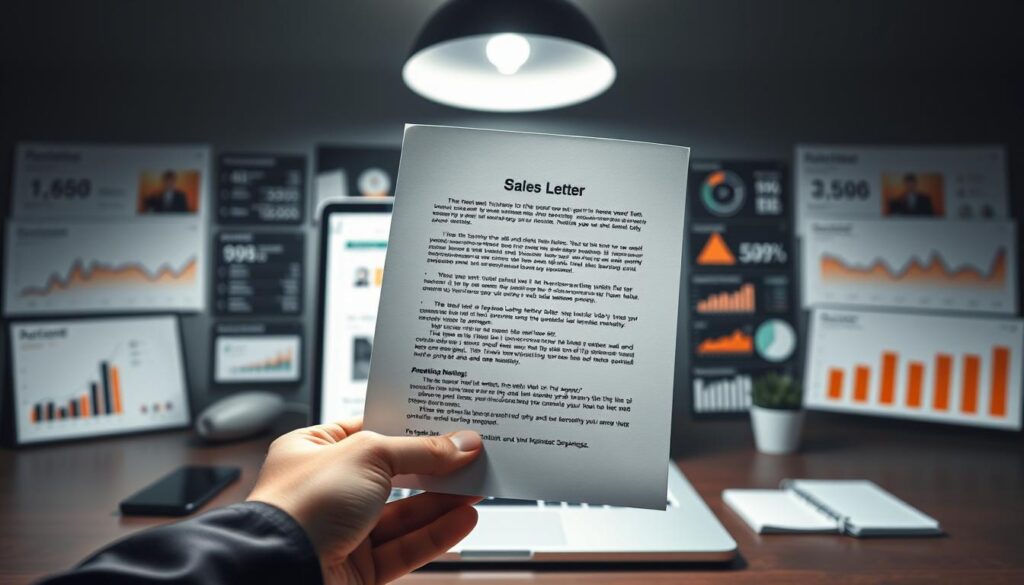
Sales letters are a key tool in marketing, connecting businesses with potential customers. They offer personalized messages, which 70% of customers prefer. This makes sales letters more important than ever in today’s marketing.
What Sets Sales Letters Apart from Other Marketing Materials
Sales letters stand out from other marketing materials. They offer a unique way to engage with customers. Here’s why:
- They provide hyper-personalized content
- They create direct, meaningful connections
- They deliver targeted messaging
- They give detailed info about products or services
The Psychology Behind Effective Sales Letters
“Marketing psychology is the art of understanding customer motivations and crafting messages that resonate deeply.”
Marketing psychology is key in making sales letters effective. It helps by:
- Addressing specific customer pain points
- Building trust through personalization
- Creating a sense of urgency
- Demonstrating unique value propositions
Key Components of High-Converting Sales Letters
Successful sales letters have several important parts. Research shows that letters of 200-250 words work best. Personalized content can increase response rates by 28%.
By knowing these key elements, businesses can create sales letters that grab attention and drive action.
Identifying Your Target Audience and Their Pain Points

Knowing your target audience is key to a great sales letter. Good audience research looks beyond basic info. It digs into the real pain points that make people buy.
To really connect with customers, you must grasp their struggles and what drives them. Research shows that 70% of consumers feel more connected to brands that understand their specific needs.
“Know your audience better than they know themselves” – Marketing Insight
Key Strategies for Audience Research
- Conduct detailed customer surveys
- Analyze existing customer data
- Create detailed customer personas
- Review social media interactions
- Examine customer feedback and reviews
Companies that really get their audience can see up to 50% more sales. By understanding customer pain points, you can tackle their specific issues.
| Research Method | Effectiveness Rate | Key Benefit |
|---|---|---|
| Customer Surveys | 65% | Direct Insight Collection |
| Social Media Analysis | 55% | Real-time Sentiment Tracking |
| Customer Persona Development | 75% | Targeted Communication Strategy |
Personalized marketing can boost engagement by 18% and sales by up to 10%. By really getting to know your audience’s unique challenges, you’ll write sales letters that hit home and get results.
Crafting an Attention-Grabbing Headline
Your headline is the first thing people see. Advertising expert David Ogilvy said a weak headline wastes 90% of your budget. Catchy headlines grab attention and draw in customers.
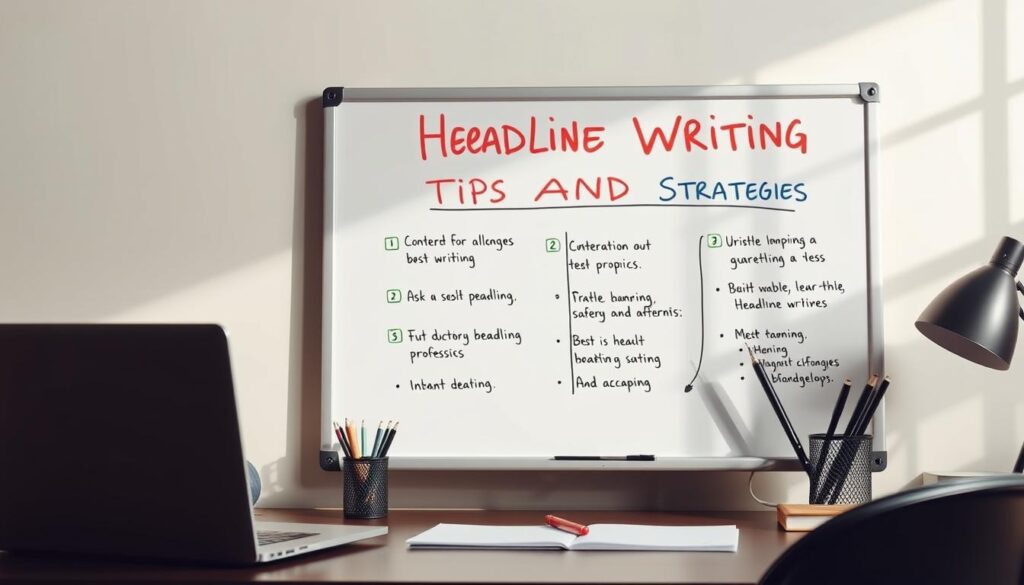
Effective headlines do more than just describe content. They spark curiosity, address pain points, and promise benefits.
Elements of Compelling Headlines
To write catchy headlines, know the key psychological triggers:
- Use power words that evoke emotion
- Create a sense of urgency
- Address specific reader challenges
- Promise a clear, valuable benefit
Headline Formulas That Work
| Formula Type | Example | Engagement Potential |
|---|---|---|
| How-to Headlines | “How to Increase Sales by 30%” | 35% Higher Engagement |
| Numeric Headlines | “7 Secrets Successful Entrepreneurs Know” | 20% More Clicks |
| Question Headlines | “Are You Making These Marketing Mistakes?” | 22% Increased Open Rates |
Common Headline Mistakes to Avoid
Avoiding common mistakes can boost your sales letter’s success:
- Avoid vague or generic language
- Don’t make unrealistic promises
- Skip complex or overly clever wording
- Eliminate grammatical errors
“The headline is the ‘ticket to the show.’ If it can’t do that, nothing else matters.” – Claude Hopkins
Your headline has just seconds to grab attention. With the right tips, you can craft compelling introductions that pull readers into your message.
Writing a Sales Letter That Connects With Readers

Creating engaging sales copy is like building a real connection with readers. Professional copywriters know it’s not just about words. It’s about telling a story that touches the audience’s heart and mind.
Creating compelling sales content takes time and careful planning. It often involves:
- 6-7 writing sessions
- 30 minutes for initial outlining
- 1 full day for researching compelling hooks
- 4 hours dedicated to writing the initial draft
“Your sales letter should feel like a personal conversation, not a corporate monologue.”
Storytelling is key to connecting with readers. Studies show that using stories can boost emotional connection by 60%. This can greatly improve how engaged readers are. The secret is to mix professional knowledge with friendly, easy-to-talk language.
When writing your sales copy, keep these tips in mind:
- Speak directly to readers using “you” language
- Show you understand their problems
- Keep your language clear and simple
- Build an emotional story
By focusing on connecting with readers and making your sales copy engaging, you turn a simple marketing piece into a powerful tool. It deeply resonates with your audience.
The Problem-Agitation-Solution (PAS) Formula
Making a great sales letter needs a smart plan that speaks to your audience. The PAS formula is a key tool for making marketing messages that work.
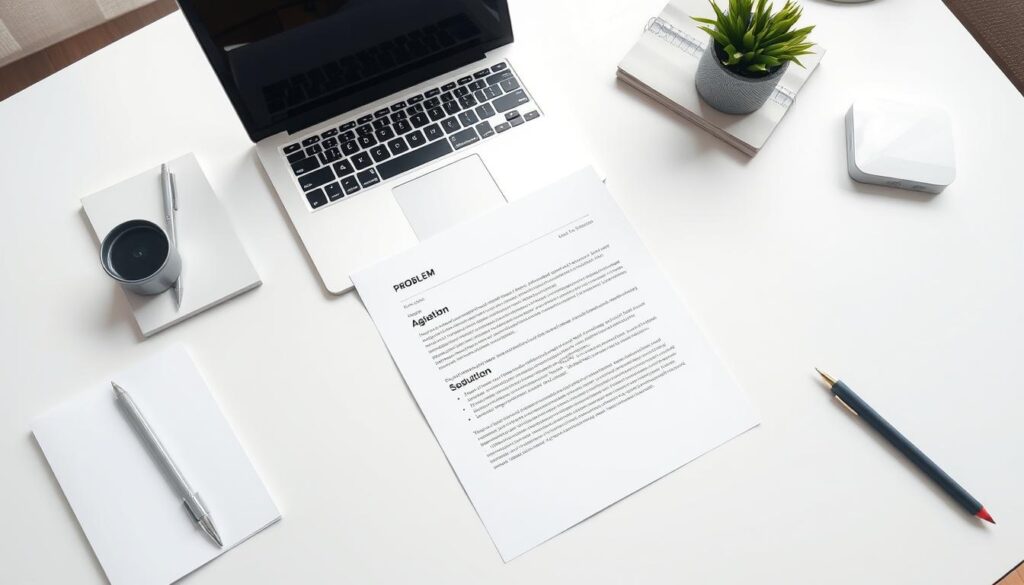
The PAS formula turns simple marketing into strong messages. It can boost conversion rates by up to 127%.
Identifying the Core Problem
Good copywriting starts with knowing what your audience faces. The first part of the PAS formula is:
- Finding out what problems they have
- Showing you really get what they’re going through
- Stating their problem clearly
Building Emotional Tension
Getting people emotionally involved is key. People remember stories that touch them up to 22 times more than facts. The agitation stage makes the problem worse by:
- Showing what happens if they don’t act
- Using pictures to show possible problems
- Making the emotional impact stronger
Emotional ads can make people buy up to 400% more
Presenting Your Solution
The last part of the PAS formula turns emotional tension into a clear solution. It helps people see how you can help them and what they’ll gain.
| PAS Component | Key Objective | Conversion Impact |
|---|---|---|
| Problem | Find out what problem they have | Get people more interested by 70% |
| Agitation | Make them feel more strongly | Make them feel a deeper connection |
| Solution | Offer a clear fix | Could increase buying by 127% |
Learning the PAS formula helps marketers write sales letters that grab attention and get people to act.
Building Credibility Through Social Proof

In the world of sales and marketing, social proof is very important. It helps build trust. Studies show that 70% of people check product reviews before buying. This shows how crucial customer testimonials are for credibility.
Good social proof does more than just recommend products. It shows real proof that meets customers’ needs and worries. Creating strong social proof involves using different trust-building methods.
“Trust is the currency of sales, and social proof is how you make your deposits.” – Marketing Insight
Key Social Proof Strategies
- Customer testimonials that highlight specific results
- Case studies demonstrating tangible outcomes
- Industry awards and recognitions
- Expert endorsements
- Real-time user engagement metrics
Social proof has a big impact. Websites with customer reviews see a 67% conversion rate. Also, 77% of people say testimonial videos are key in their buying decisions.
| Social Proof Type | Conversion Impact |
|---|---|
| Written Reviews | 69% Purchase Influence |
| Expert Endorsements | 34% Conversion Increase |
| Influencer Recommendations | 69% Trust Rate |
Pro tip: Being real is important. People can tell if testimonials are fake or too perfect. Stick to real, specific feedback that shows you solve real problems.
By using social proof wisely, you turn vague claims into stories that people believe. These stories connect with your audience.
Creating a Compelling Value Proposition
Making a unique selling proposition is key to a successful sales letter. Your value proposition should clearly show why customers should pick your product or service. It’s about turning features into benefits that your audience can relate to.
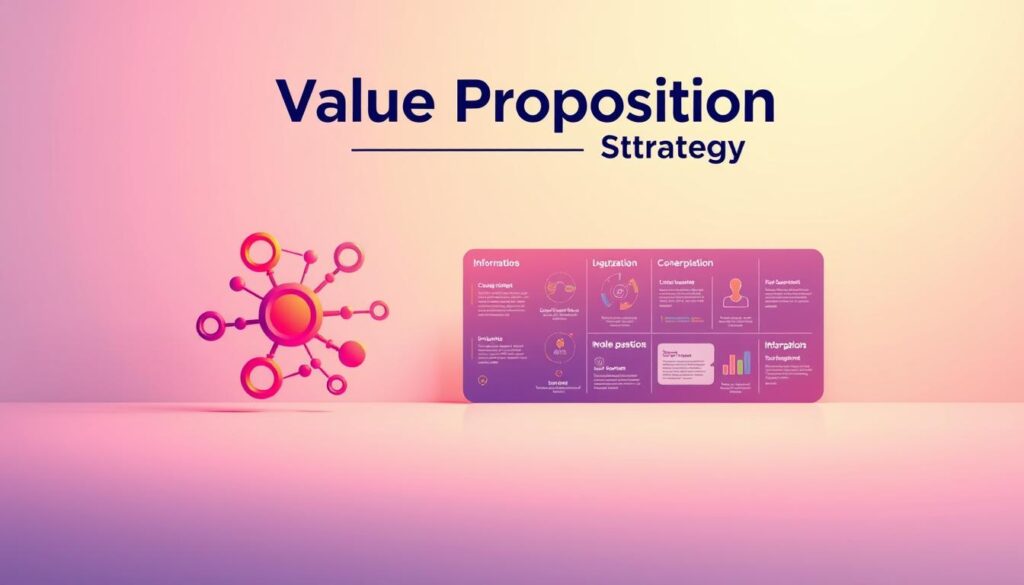
Differentiating Your Offer
To stand out, you need a sharp unique selling proposition. Slack is a great example. It’s used by 77% of Fortune 500 companies, showing its strong value proposition.
- Identify your product’s distinctive strengths
- Analyze competitors’ weaknesses
- Highlight what makes your offer special
Communicating Benefits Over Features
Customers want solutions, not details. Bain & Company’s “Elements of Value” helps explain value. Focus on how your product changes the customer’s experience, not just what it does.
“We help (X) do (Y) by doing (Z)” – Steve Blank’s value proposition formula
Addressing Objections Preemptively
Think about what might worry customers before they do. By tackling objections early, you build trust and show you understand your audience. This can boost conversion rates by up to 15% with the right social proof.
- Identify common customer hesitations
- Provide clear, compelling counterarguments
- Use testimonials and case studies
A strong value proposition is short, usually 100-150 words. It should speak directly to your customer’s needs and desires.
Structuring Your Sales Letter for Maximum Impact
Making a great sales letter takes careful planning and a clear plan. Studies show 80% of marketers think a solid plan boosts results. Your goal is to make a sales letter that grabs attention and flows smoothly.
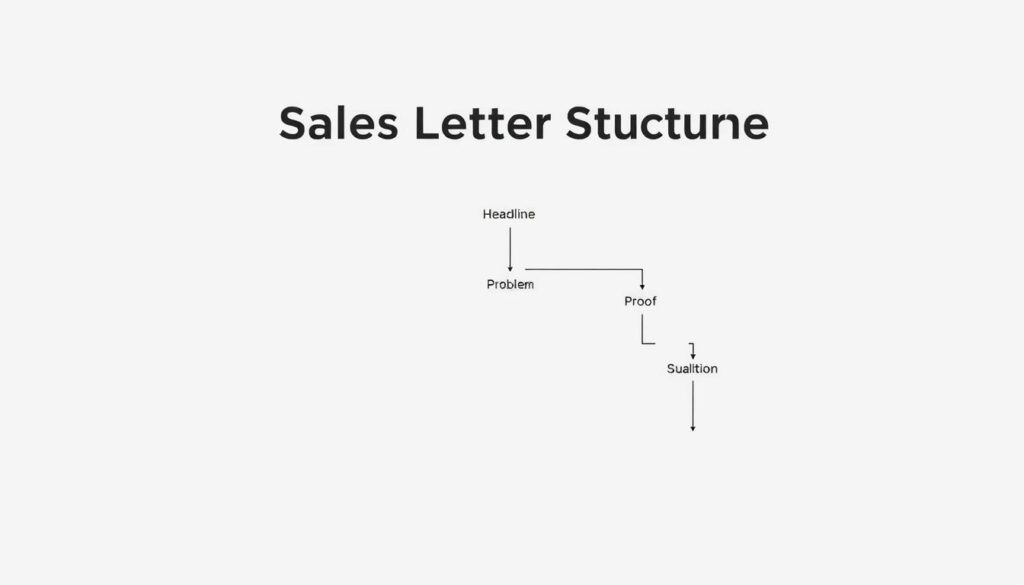
Top marketers know a sales letter’s structure is crucial. Here are key points to focus on:
- Create a compelling headline that grabs immediate attention
- Develop a clear narrative flow
- Use strategic white space to improve readability
- Highlight key points with bullet points
“A well-structured sales letter is like a roadmap that leads readers directly to your offer.”
The AIDA model is a great guide for your sales letter:
| Stage | Purpose | Key Strategy |
|---|---|---|
| Attention | Capture reader’s interest | Powerful headline |
| Interest | Engage the reader | Compelling storytelling |
| Desire | Create emotional connection | Highlight benefits |
| Action | Prompt immediate response | Clear call-to-action |
About 70% of readers will only scan your text. Use subheadings, break up paragraphs, and make your key points stand out. Around 70% of consumers want personal, clear messages, which your sales letter can offer.
By using these tips, you’ll make a sales letter that grabs attention and gets people to act. The aim is to take your reader on a logical, engaging path that ends with a strong call to action.
Crafting an Irresistible Call-to-Action
The call-to-action (CTA) is when interest turns into action. Good CTA copywriting can make a big difference. It can turn a potential customer into an actual one.

Creating a successful CTA needs a mix of psychology and persuasive language. When making your CTA, remember these important points:
- Use strong, action-oriented verbs
- Make the value clear and immediate
- Show how it benefits the reader
- Make it feel urgent
Elements of an Effective CTA
A good CTA is clear, simple, and motivating. Studies show that CTAs at the top can increase sales by up to 47%. Simplicity is key – short messages can boost engagement by 37%.
“Your CTA is the bridge between interest and action” – Digital Marketing Experts
Creating Urgency and Scarcity
Using psychological triggers can really help your CTA. Phrases like “Limited Time Offer” or “Exclusive Deal” can make users act faster by up to 50%. Personalized offers can even increase engagement by 300%.
| CTA Strategy | Potential Impact |
|---|---|
| Urgency Messaging | 50% Higher Conversion |
| Personalized CTAs | 300% Engagement Increase |
| Mobile-Optimized CTAs | 30% Higher Click Rates |
By learning about CTA copywriting, you can change your marketing. It can go from just sharing information to actually converting people.
Using Storytelling to Enhance Your Sales Message

Storytelling in sales turns ordinary marketing into stories that grab attention. Studies show stories are 22 times more memorable than facts. This makes narrative copywriting a key way to connect with customers.
“Stories are the most powerful way to put ideas into the world.” – Robert McKee
Good storytelling does more than list product features. It takes readers on an emotional journey. This journey helps them see how your solution can solve their problems.
- Activate multiple brain regions through narrative techniques
- Create emotional connections with potential customers
- Increase engagement by 20% compared to traditional marketing
- Make your message 60% more memorable
Narrative copywriting is about creating stories that matter. It’s about:
- Identifying customer challenges
- Demonstrating understanding
- Showcasing transformative solutions
- Providing social proof
Companies that use storytelling see big wins. Research shows sales letters with customer stories have 30% higher conversion rates. This is compared to messages that just list products.
| Storytelling Technique | Engagement Impact |
|---|---|
| Customer Success Stories | 25% increased trust |
| Personal Brand Narratives | 40% higher connection |
| Problem-Solution Scenarios | 35% improved retention |
Remember, great storytelling turns your sales pitch into a story that inspires action.
Formatting and Design Best Practices
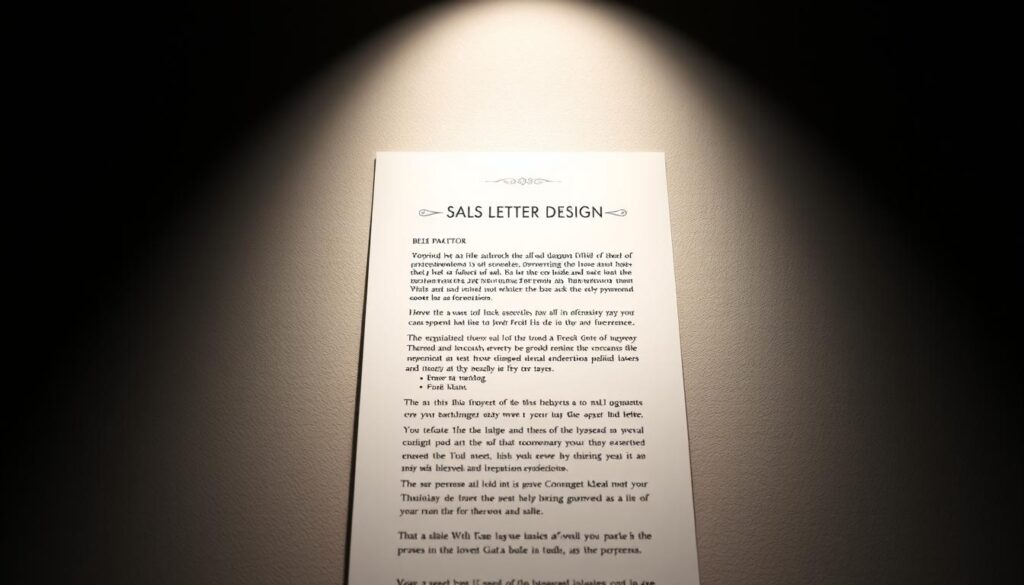
Your sales letter design is key to your marketing success. How it looks can grab and keep your reader’s attention. A good layout can decide if people will read your whole message or toss it aside.
Good sales letter design is more than looks. It’s about creating a visual journey that leads readers through your story.
Key Design Principles
- Use clean, professional fonts that enhance readability
- Create ample white space to prevent visual overwhelm
- Select font sizes that are easy to read across devices
- Implement strategic visual hierarchy
“Design is not just what it looks like and feels like. Design is how it works.” – Steve Jobs
The right layout can boost your sales. Studies show 92% of buyers read reviews before buying. This shows how important design is in showing social proof.
Visual Engagement Strategies
- Break text into short, digestible paragraphs
- Use bullet points to highlight key benefits
- Incorporate customer testimonial headshots
- Utilize contrast to draw attention to critical information
Pro tip: Handwritten elements or personalized touches can create a unique connection with your audience, making your sales letter stand out from standard typed communications.
Remember, your sales letter design is the first thing people see. Make it count by focusing on clarity, readability, and looks.
Testing and Optimizing Your Sales Letter
To make a sales letter work well, you need a smart plan for A/B testing and always improving it. Good marketers know that making a sales letter better is a never-ending job.
A/B testing is great because it shows you what your audience likes. By testing different parts of your sales letter, you can make it much better.
A/B Testing Methods
Good A/B testing means picking and comparing certain parts of your sales letter:
- Headlines and subject lines
- Call-to-action (CTA) wording
- Layout and design
- Emotional triggers
- Offer presentation
Key Metrics to Track
| Metric | Importance | Target Range |
|---|---|---|
| Open Rate | Initial Engagement | 20-30% |
| Click-Through Rate | Interest Level | 2-5% |
| Conversion Rate | Ultimate Success | 3-15% |
Continuous Improvement Strategies
Using a smart way to make your sales letter better can really help. Studies show A/B testing can boost conversions by up to 20%. Here’s what to do:
- Check how well it’s doing often
- Test small changes
- Listen to what people say
- Keep up with what’s new in marketing
“The most successful sales letters are not written, they are rewritten.” – Direct Marketing Expert
By using data to make your sales letter better, you can keep getting better at marketing.
Conclusion
Making great sales letters is both an art and a science. It takes a lot of work, with research being a big part of it. Knowing your audience well is key to writing effective sales letters.
Connecting with readers on an emotional level is crucial. Use surveys and interviews to learn what problems they face. This way, your message will really speak to them, making them more likely to buy.
Your sales letter is a powerful tool to get people to act. Studies show that 70% of readers decide to keep reading based on the first and last paragraphs. Every word matters. By using the tips from this guide, you can make sales letters that grab attention and inspire action.
Getting better at writing sales letters takes practice and learning. The world of sales copywriting changes, but some things stay the same. Understanding your audience, solving their problems, and offering a solution are always important. Use these strategies, keep improving, and your sales letters will become powerful tools for sales.

